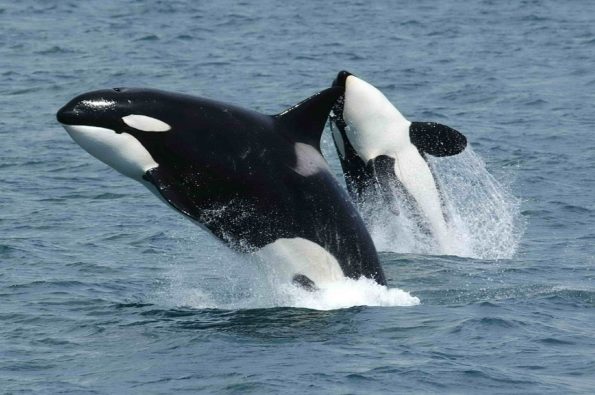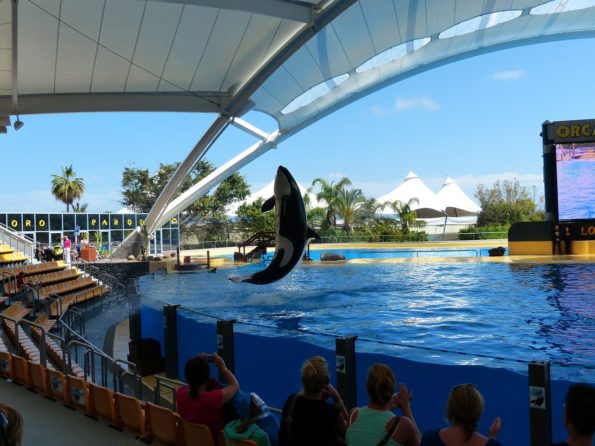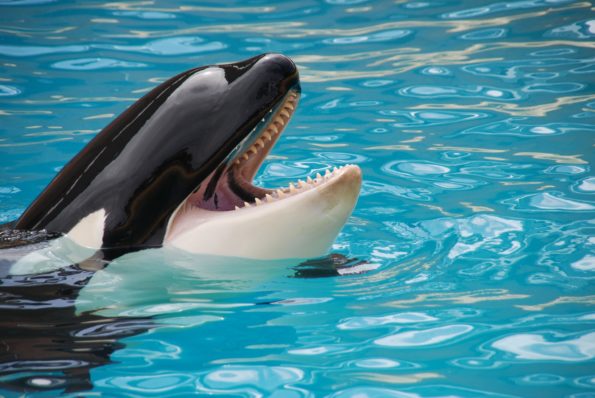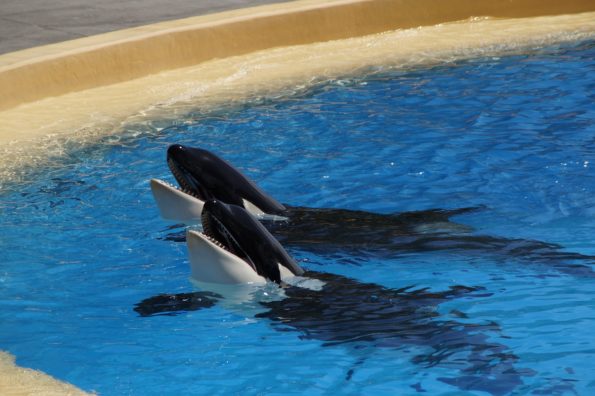
[dropcap]O[/dropcap]rca whales are fascinating, social creatures that are incredibly skilled predators. They hunt on a variety of sea life, though humans are not a part of their natural diet. Though, for some reason, encounters with orcas in captivity share a different story. In 1990, a twenty-two and a half foot long orca whale named Tilikum was the largest in captivity. Due to his size, all of the trainers and handlers couldn’t swim with him in the pool, because there was a risk of being accidentally drowned. He was placed in a tank with two other killer whales, for about a year before tragedy struck. According to “The Story Behind Tilikum the Killer Whale” by Martin Evens, in 1991 Tilikum and the two other whales in captivity dragged a part-time trainee into the tank, submerging her underwater until she drowned. That following January, Tilikum was moved to SeaWorld in Orlando, Florida.
Reading this, some might think that Tilikum is a monster, and that the trainee was the only victim in this situation. And that may be true, but it’s important to look at other factors as well, such as the treatment the orcas were receiving in their habitats, how being in captivity tampered with their natural instinct. The death was a tragedy, one that could have been prevented.
From the audience…
Watching a whale show at SeaWorld is a fun, thrilling event. Whales and dolphins, flying to and fro, seals performing incredible flips and tricks, leaping from the water to catch a fresh fish. Handler and orca, cooperating side by side to wow and entertain the people watching. The animals seem fine, healthy, their happiness enforced by the trainer’s joyful commentary.
From the public’s eye, SeaWorld is a haven for rescued sea life, where they can roam around and provide entertainment. But from former and current handlers, it’s a whole other story, hidden from the audience and set aside by the company and those who work there.
How do orcas treat each other in captivity?

Sarah Fischbeck, a former SeaWorld employee, describes the behavior of the orcas who were put into captivity. She says that with being kept in tanks tiny compared to how they would live in the wild, hostility is common between orcas. The stress of living inside of a glass box causes the whales to lash out at each other.
Fischbeck told The Dodo in an interview that the handlers that worked there would find rake-marks on the orcas backs, from them fighting each other and peeling the skin off of each other. She said they would find strips of rubber-like substances on the floor of the tank, and soon realized it was their skin. “They’re always beating up on each other,” Fischbeck explained. “It’s nothing new. The trainers know it, we know it.” This is only the beginning of the morbidity that occurs in show aquariums like this.
The performances
During performances, you might see that the animals are beckoned to do tricks with the promise of food, which they are rewarded with after they complete their task. Though, as some former employees have said, when the orcas do not perform their act well or refuse to do so, they are punished by having food withheld from them. These are predators and carnivores, who have the natural instinct to hunt for food on their own in the ocean. They are being stripped of their natural habits and instinct. And this does not lead to happy consequences.

One incident in October 2007, where an orca trainer named Claudia Vollhardt almost died at the Lora Parque Zoo in Spain. She was training a 3,000 pound orca named Tekoa, when disaster struck. She was having trouble with him in practicing a “foot push”, a move used in performances. “After a few failed attempts, Tekoa grabbed Vollhardt’s arm and took her to the bottom of the pool. He then dragged her toward the steel gate between the show pool and the back pools and began banging her against it,” says writer at The Dodo.
These animals are forced into living in a world of pleasing other beings for commercial use, for profit. Controlled and bribed into mindless performances all for a few bucks in the company’s back pocket.
The unhealthy side of captive orcas
According to “THE FATE OF CAPTIVE ORCAS” by a WDC writer, there was a mass round-up of over eighty orca whales being captured in Penn Cove, Washington, in 1970. At least five of those orcas died in the process, being forced into aquariums and parks. Now, only one of those orcas remain alive to this day.
This article also states that the lifespan for male orcas is 40-70 years old, and for females it can be up to 100. Orcas in nature live significantly longer than those in captivity. It’s not uncommon for orcas in SeaWorld and other locations to get diseases or die of stress. As PETA puts it, ” In captivity, these animals can only swim in endless circles in tanks that are the equivalent of bathtubs.” [perfectpullquote align=”left” bordertop=”false” cite=”” link=”” color=”” class=”” size=””]These animals are forced into living in a world of pleasing other beings for commercial use, for profit. [/perfectpullquote]
Orcas in captivity suffer from extreme psychological and physical turmoil from being held from their families and restricted from doing things they could do in the wild. There have been many cases where their teeth have been damaged, the enamel wearing off or even teeth falling out, because they chew on the metal bars along their tanks.
According to “Killer Whale Dorsal Fin Collapse” by ThoughtCo writer Jennifer Kennedy, all male orcas in captivity have collapsed dorsal fins, a condition that rarely occurs in the wild. “One theory as to why dorsal fins collapse in captivity is because the orca spends much of its time at the water surface and doesn’t swim very far. This means that the fin tissue gets less support than it would if the orca were in the wild, and it starts to fall over. The whales also often swim in a repetitive circular pattern,” says Kennedy, hypothesizing that the way orcas do not have much room to free roam can contribute to this condition. She also notes that it is a sign of a lack of health, caused by extreme stress and a drastic change in diet. This is common for ALL captive orcas.
An artificial diet

Orcas have a variety of food sources. They’re known as annex predators, at the top of the food chain, hunted by no other animals besides humans. According to LiveScience writer Alina Bradford, they hunt for fish, sea lions, octopi, sharks, rays, and much more. They’re complex and diverse diet allows for them to be very active hunters. They also rely on eachother. “Orcas will also work together to catch larger prey or groups of prey such as schools of fish” says Bradford.
Though, in the wild, they aren’t given much other than raw fish. They are maybe put in an enclosure with one other orca, but otherwise do not have many chances to be social. Consequently, this would cause health defects.
The other side….
There are many arguments to oppose the treatment or orcas in captivity, but there is also another side to every story. According to MotherJones writer Tanseem Raja, Seaworld has a striking defense to the huge backlash they received following release of the Documentary Blackfish, which reveals the horrors and mistreatment that occurs in sea-life parks. “Whales in SeaWorld’s care help science better understand and conserve wild killer whales,” states the company, and later on donating 10 million dollars to orca research.
What is being done now?

Though there are many things that still need to be changed in the way we treat the orcas that reside in our oceans, there are lengths being taken to protect them and end the abuse happening within aquarium parks. Some SeaWorld locations like the one in California have closed their orca shows. They plan on closing more in Florida and Texas in 2019, which is an important step forward. Though, some say that these efforts, however valid, aren’t urgent enough to make a difference, considering all of the other locations throughout the US that plan on continuing their wildlife shows.
Conclusion
In the wild, Orcas and other sealife have vast natural habitats that have complex social structures. In groups of up to 40, called “pods”, they communicate and bond with family and friends in their environment. They have endless amounts of space to roam free and do as they please. [perfectpullquote align=”right” cite=”” link=”” color=”” class=”” size=””]As PETA puts it, ” In captivity, these animals can only swim in endless circles in tanks that are the equivalent of bathtubs.”[/perfectpullquote]
They’re torn away from their families, removed from their natural habitats, and trained to perform tricks with the promise of food, which is not nearly as plentiful or diverse as the food they would hunt in the wild. Being isolated from their communities and family causes a great deal of stress, resulting in consequences for both sides.People get hurt, killed even, from whales lashing out on their trainers. Ocras deal with sickness and disease from their artificial life, this and stress causing deaths among those in captivity.
These are magnificent, beautiful, complex animals who rely on their environment and social structure to survive. It’s our jobs as humans to protect and honor them, and most importantly leave them alone in their natural habitats.
What can I do to help?
You can donate to the many organizations (like this one) fighting for orcas in captivity to have better treatment or simply be released back into the natural world. Though, some who were born into their artificial lives are unable to adapt to the natural ways of life in the ocean, so what could be done is putting those orcas into nature reserves, where they can be put into a safer environment with less health dangers exposed to them. It’s crucial to their happiness, health, and survival that they have an open space to roam, a healthy complex diet, and a good social system.
Featured image by Pixabay
